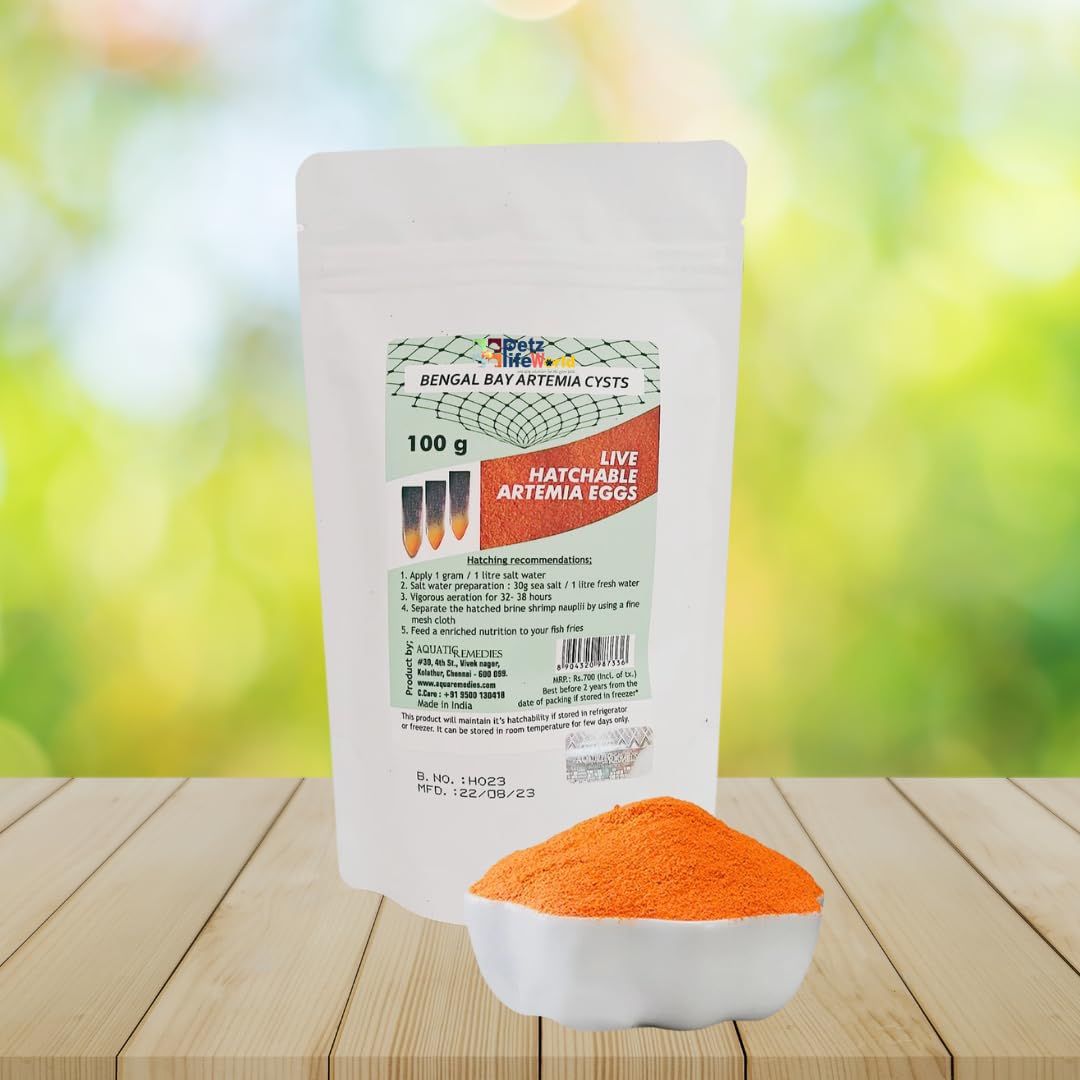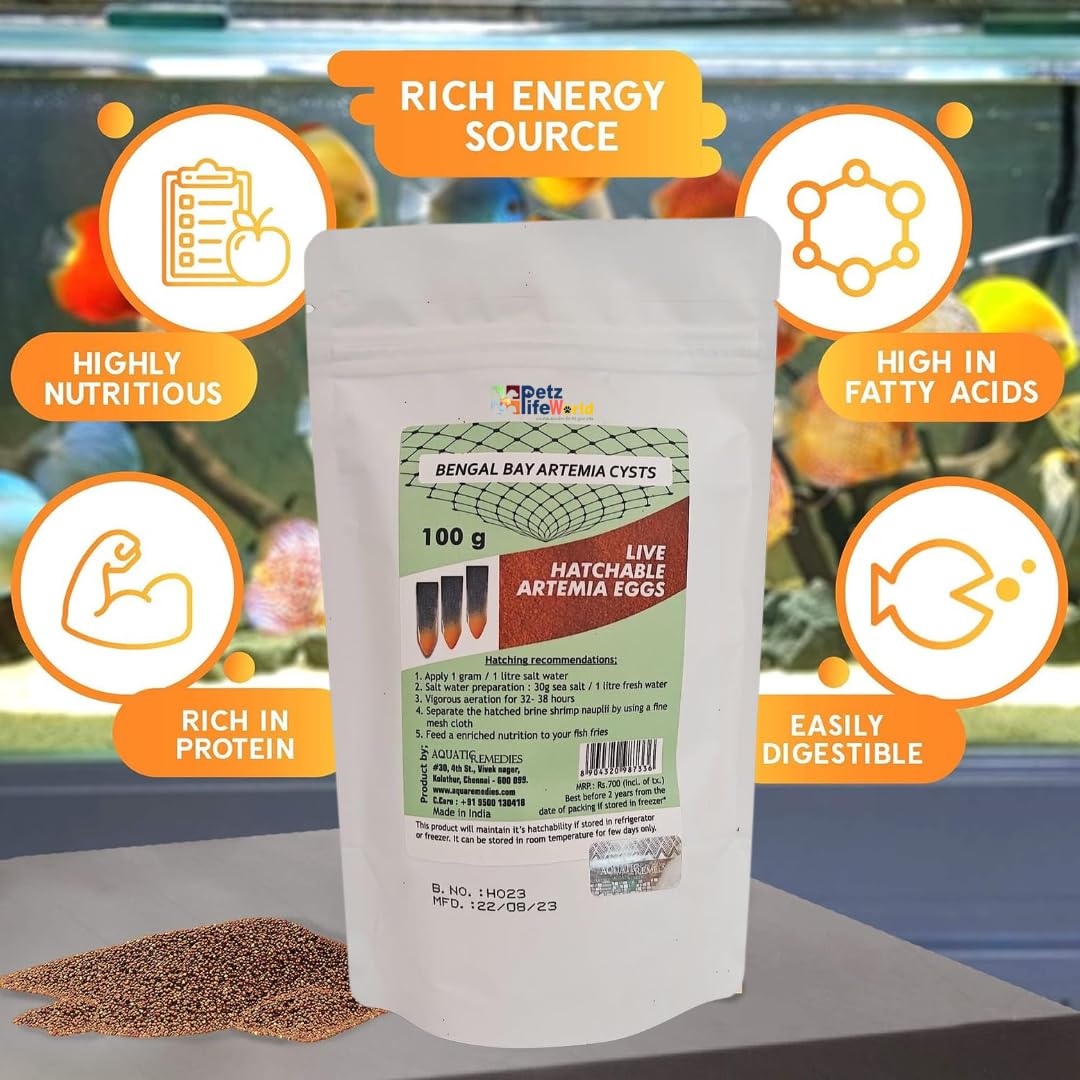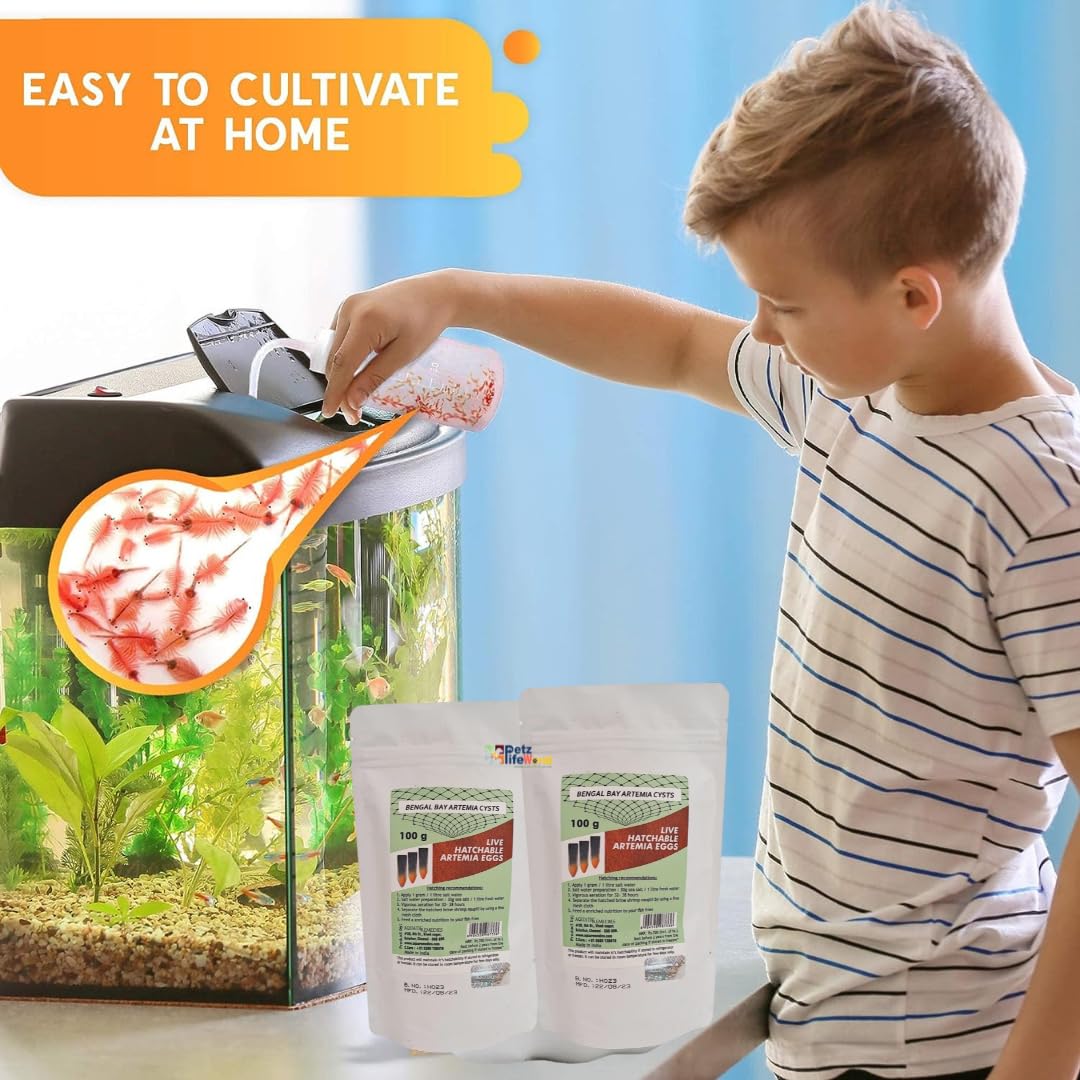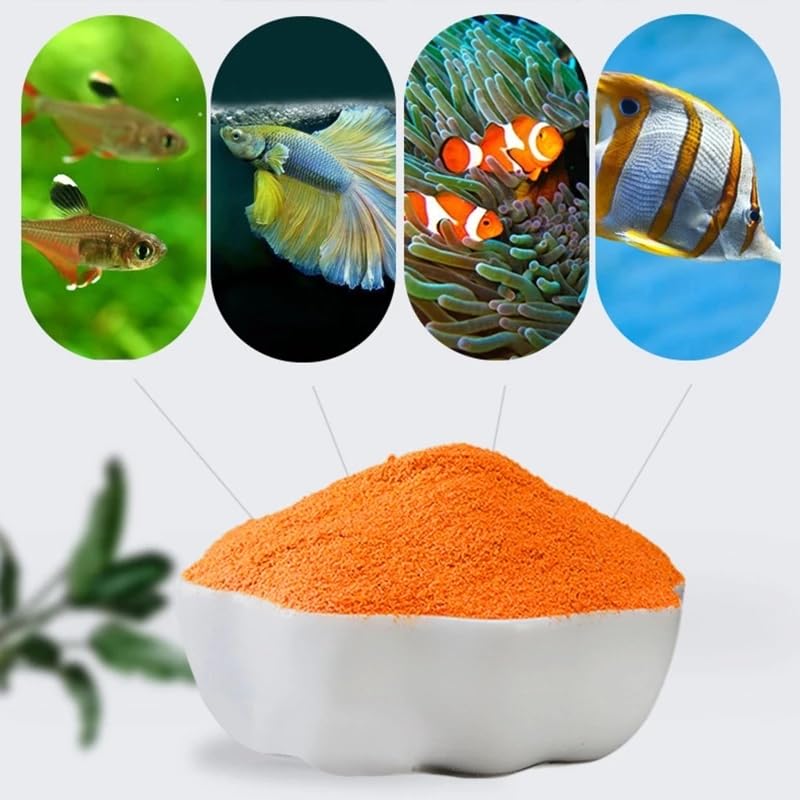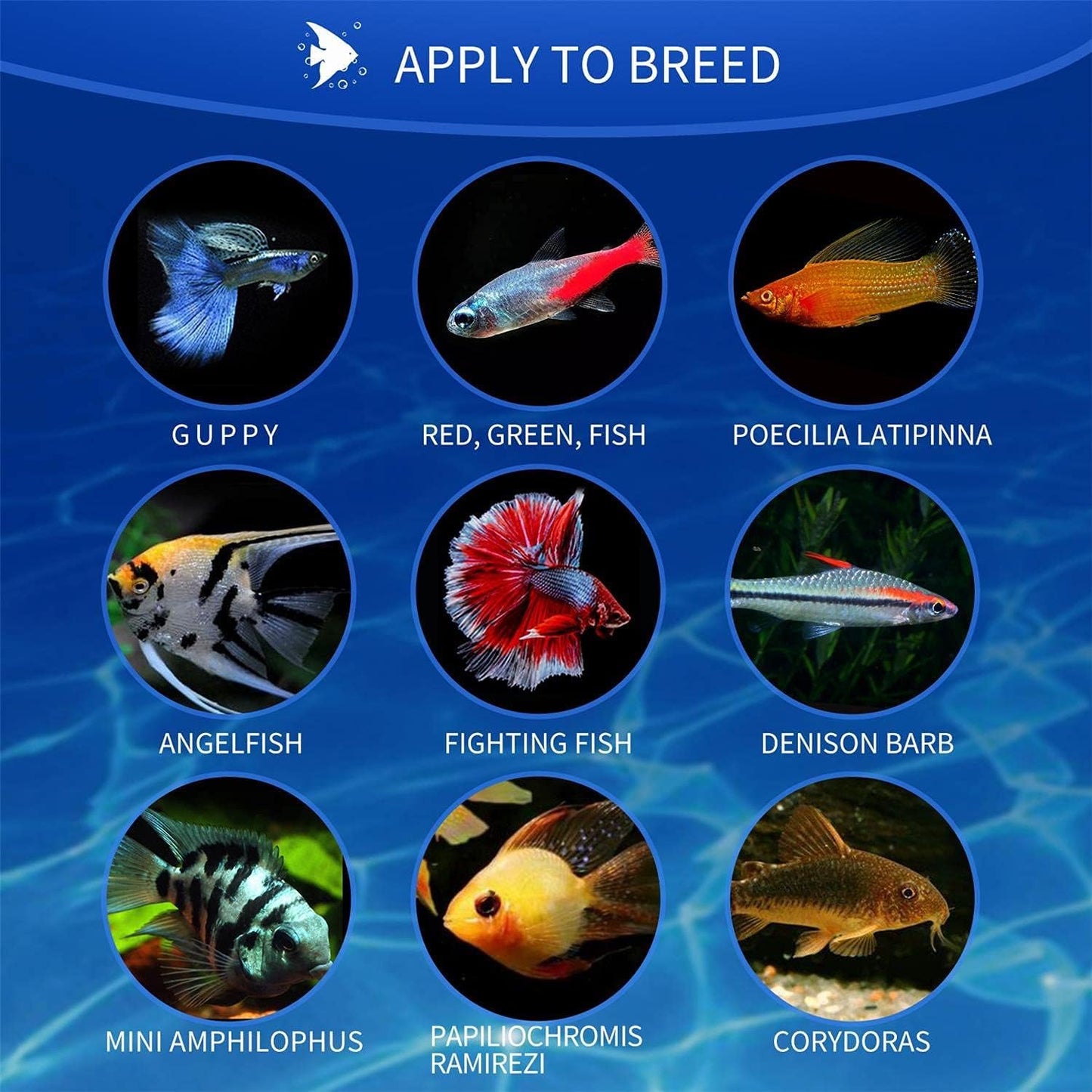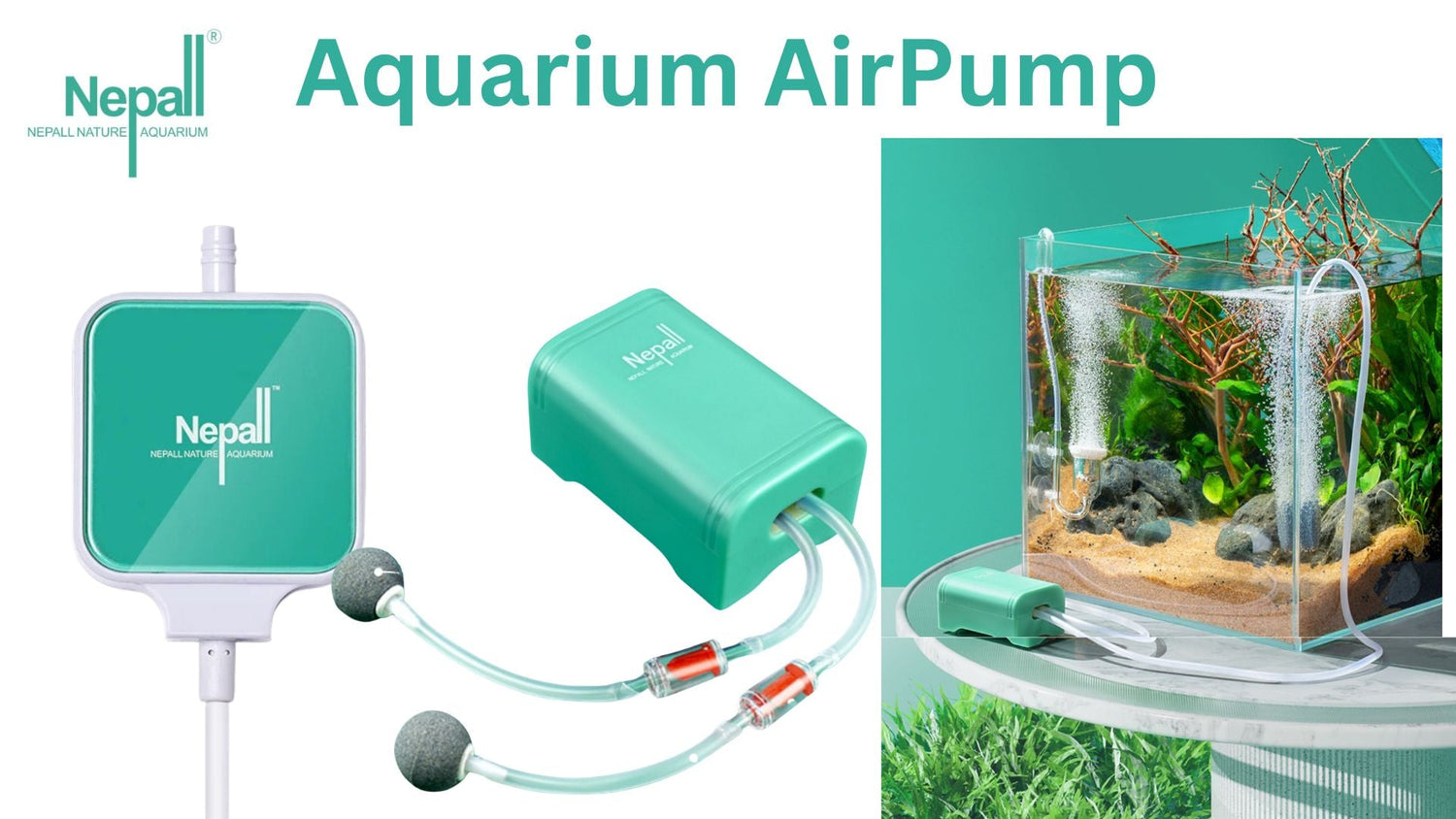PetzLifeworld Bengal Bay 100g (0.22 Oz) Artemia Cysts - 90% Hatch Rate for Baby & Fry Fish
PetzLifeworld Bengal Bay 100g (0.22 Oz) Artemia Cysts - 90% Hatch Rate for Baby & Fry Fish
 Free Shipping
Free Shipping
 7 Days Easy Return
7 Days Easy Return
 Low Price
Low Price
Couldn't load pickup availability
- Bengal Bay Artemia cysts likely refer to a type of brine shrimp cysts sourced from the Bengal Bay region. Artemia cysts are commonly used in aquaculture and aquarium hobbyist settings as a source of live food for fish and other aquatic organisms. These cysts contain dormant embryos of brine shrimp, which can hatch into live Artemia nauplii when exposed to the right conditions.
- The Bengal Bay, also known as the Bay of Bengal, is a large body of water located in the northeastern part of the Indian Ocean, bordered by several countries including India, Bangladesh, Myanmar, Thailand, and others. The region may be known for harvesting Artemia cysts from salt ponds or saline water bodies found along its coast.
- Artemia cysts are valued for their nutritional value and ease of hatching. They are often used to feed newly hatched fish and other aquatic organisms in aquaculture hatcheries, research facilities, and home aquariums. When these cysts are properly hatched, they provide a readily available source of small, live prey that is ideal for many fish and invertebrates during their early stages of development.
- To use Bengal Bay Artemia cysts or any other type of Artemia cysts, you typically rehydrate them in saltwater, provide aeration, and maintain appropriate water conditions to stimulate hatching. Once the cysts hatch, you can harvest the live nauplii to feed to your aquatic organisms.
- The specific characteristics of Artemia cysts from the Bengal Bay region may vary, so it's essential to follow the manufacturer's instructions or consult with experts in the field for the best practices regarding their use in your particular application.
Secure Payments
Secure Payments
Secure Payment Through Razorpay – Why You Can Trust Us
At PetzLifeworld, your safety and satisfaction are our top priorities. We’ve partnered with Razorpay, a trusted and secure payment gateway, to ensure your transactions are completely safe and hassle-free. Here's why Razorpay is a reliable choice for your payments:
1. Industry-Leading Security Standards
- Razorpay uses PCI DSS Level 1 Compliance, the highest standard of security in the payment industry.
- All transactions are encrypted using 256-bit SSL encryption, ensuring your sensitive data is fully protected.
2. Multiple Payment Options
With Razorpay, you can choose from a wide range of secure payment methods:
- Credit/Debit Cards: Visa, MasterCard, Maestro, American Express, and more.
- Net Banking: Supported by all major Indian banks.
- UPI Payments: Pay seamlessly using Google Pay, PhonePe, Paytm, or any UPI-enabled app.
- Wallets: Integrated support for wallets like Paytm, Freecharge, and others.
- EMI Options: Flexible EMI plans for eligible credit cards.
3. Fraud Detection and Prevention
Razorpay’s advanced fraud detection system continuously monitors transactions to protect against fraudulent activities, giving you peace of mind with every payment.
4. Instant Confirmation
Once your payment is processed, you will receive an immediate confirmation via email and SMS, ensuring transparency.
5. Simplified Refunds
If you ever need a refund, Razorpay makes the process smooth and quick. Refunds are securely processed and reach your account within the shortest possible time.
How to Pay Securely Through Razorpay
- Select your product and proceed to checkout.
- Choose Razorpay as your payment method.
- Enter your details securely, following the prompts.
- Complete your transaction and receive an instant confirmation.
Shop with confidence at PetzLifeworld, knowing your payments are powered by Razorpay—a gateway trusted by millions for safe and seamless online transactions.
For any payment-related queries, feel free to contact us at petzlifeworld@gmail.com or 9952502573.
Return & Replacement Policy
Return & Replacement Policy
At PetzLifeWorld, we strive to ensure our customers are satisfied with their purchases. If something doesn’t go as planned, we’re here to help with a fair and transparent return and replacement policy. Please read the details below carefully to understand the eligibility and process.
1. Returns for Damaged Products
If your product arrives damaged during transit, we will process your return under the following conditions:
- You must provide an unboxing video clearly showing the damage.
- The unboxing video should start from the sealed package and show the product inside.
- Submit your return request along with the unboxing video within 7 days of delivery.
Note: Returns without an unboxing video or submitted after 7 days will not be accepted.
2. Replacement for Wrong or Incorrect Products
We will replace products if:
- You receive a product that is different from what you ordered.
- The product is unused and in its original packaging.
What to Do:
- Contact us within 7 days of delivery with proof (e.g., a photo of the received item and the invoice).
- We will arrange for a replacement of the correct product.
3. Product Interchange
If you wish to exchange your purchased product for a different model or product, the following terms apply:
- The original product must be unusable for its intended purpose.
- Additional shipping charges will apply for the new product's delivery.
- The request must be made within 7 days of delivery.
How to Initiate a Return or Replacement
- Contact Us Via Email Or Whats App:
- Provide the necessary details:
- Follow the instructions from our customer support team to complete the process.
Important Notes
- Non-Returnable Items: Certain products such as perishable items, custom orders, or clearance sale items may not be eligible for return or replacement.
- Shipping Costs: Ineligible returns or exchanges will require the customer to bear all shipping costs.
- Inspection Process: Returned products will undergo a quality check before approval for refund, replacement, or interchange.
Thank you for choosing PetzLifeWorld. We appreciate your trust in us and are committed to resolving any concerns promptly.
Shipping Policy
Shipping Policy
At PetzLifeWorld, we prioritize fast and secure shipping to ensure your orders reach you promptly and in perfect condition. Below are the details of our shipping terms and process:
Fast Shipping Terms
- Same-Day Dispatch:
- Next-Day Dispatch:
Our Process
- Secure Packing: To ensure the safety of your products during transit, every order is packed carefully and securely.
- Order Processing: While we work swiftly, please note that we process multiple orders daily. Your patience allows us to maintain high-quality standards in packing and shipping.
Shipping Notifications
- You will receive an email or SMS with your tracking information once your order is shipped.
- Use the tracking link to stay updated on your order’s progress.
Delivery Timeframes
- Delivery times vary based on your location and shipping method. Typical delivery timelines will be communicated during checkout.
Thank you for choosing PetzLifeWorld! We are committed to providing you with a seamless and secure shopping experience. For any queries regarding your shipment, feel free to contact our support team at [petzlifeworld@gmail.com] or What's App us at [+91 8122138233].
Share
